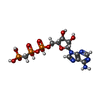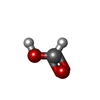[English] 日本語
 Yorodumi
Yorodumi- PDB-1saz: Membership in the ASKHA Superfamily: Enzymological Properties and... -
+ Open data
Open data
- Basic information
Basic information
| Entry | Database: PDB / ID: 1saz | ||||||
|---|---|---|---|---|---|---|---|
| Title | Membership in the ASKHA Superfamily: Enzymological Properties and Crystal Structure of Butyrate Kinase 2 from Thermotoga maritima | ||||||
 Components Components | Probable butyrate kinase 2 | ||||||
 Keywords Keywords | TRANSFERASE / ASKHA (ACETATE AND SUGAR KINASES / HSC70 / ACTIN) SUPERFAMILY / BUTYRATE KINASE / ACETATE KINASE / ISOBUTYRATE KINASE / TWO SIMILAR DOMAINS / AMPPCP / BUTYRATE / ISOBUTYRATE / DISULFIDE BOND / ENZYME MECHANISM | ||||||
| Function / homology |  Function and homology information Function and homology informationbutyrate kinase / butyrate kinase activity / acetate kinase activity / acetate metabolic process / ATP binding / cytoplasm Similarity search - Function | ||||||
| Biological species |   Thermotoga maritima (bacteria) Thermotoga maritima (bacteria) | ||||||
| Method |  X-RAY DIFFRACTION / X-RAY DIFFRACTION /  SYNCHROTRON / SYNCHROTRON /  MAD / Resolution: 2.5 Å MAD / Resolution: 2.5 Å | ||||||
 Authors Authors | Diao, J. / Cooper, D.R. / Sanders, D.A. / Hasson, M.S. | ||||||
 Citation Citation |  Journal: J.Bacteriol. / Year: 2009 Journal: J.Bacteriol. / Year: 2009Title: Crystal structure of butyrate kinase 2 from Thermotoga maritima, a member of the ASKHA superfamily of phosphotransferases. Authors: Diao, J. / Hasson, M.S. #1: Journal: Acta Crystallogr.,Sect.D / Year: 2003 Title: Crystallization of Butyrate Kinase 2 from Thermotoga Maritima Mediated by Vapour Diffusion of Acetic Acid Authors: Diao, J.S. / Cooper, D.R. / Sanders, D.A. / Hasson, M.S. | ||||||
| History |
|
- Structure visualization
Structure visualization
| Structure viewer | Molecule:  Molmil Molmil Jmol/JSmol Jmol/JSmol |
|---|
- Downloads & links
Downloads & links
- Download
Download
| PDBx/mmCIF format |  1saz.cif.gz 1saz.cif.gz | 91 KB | Display |  PDBx/mmCIF format PDBx/mmCIF format |
|---|---|---|---|---|
| PDB format |  pdb1saz.ent.gz pdb1saz.ent.gz | 68.7 KB | Display |  PDB format PDB format |
| PDBx/mmJSON format |  1saz.json.gz 1saz.json.gz | Tree view |  PDBx/mmJSON format PDBx/mmJSON format | |
| Others |  Other downloads Other downloads |
-Validation report
| Summary document |  1saz_validation.pdf.gz 1saz_validation.pdf.gz | 730.7 KB | Display |  wwPDB validaton report wwPDB validaton report |
|---|---|---|---|---|
| Full document |  1saz_full_validation.pdf.gz 1saz_full_validation.pdf.gz | 742.2 KB | Display | |
| Data in XML |  1saz_validation.xml.gz 1saz_validation.xml.gz | 19.3 KB | Display | |
| Data in CIF |  1saz_validation.cif.gz 1saz_validation.cif.gz | 25 KB | Display | |
| Arichive directory |  https://data.pdbj.org/pub/pdb/validation_reports/sa/1saz https://data.pdbj.org/pub/pdb/validation_reports/sa/1saz ftp://data.pdbj.org/pub/pdb/validation_reports/sa/1saz ftp://data.pdbj.org/pub/pdb/validation_reports/sa/1saz | HTTPS FTP |
-Related structure data
| Related structure data | |
|---|---|
| Similar structure data |
- Links
Links
- Assembly
Assembly
| Deposited unit | 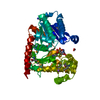
| ||||||||
|---|---|---|---|---|---|---|---|---|---|
| 1 | x 8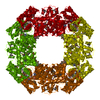
| ||||||||
| Unit cell |
| ||||||||
| Components on special symmetry positions |
| ||||||||
| Details | The biological assembly is an octamer generated from the monomer in the asymmetric unit by the operations: -X,-Y,Z; -Y,X,Z; Y,-X,Z; -X,Y,-Z; X,-Y,-Z; Y,X,-Z; and -Y,-X,-Z |
- Components
Components
| #1: Protein | Mass: 43474.957 Da / Num. of mol.: 1 Source method: isolated from a genetically manipulated source Source: (gene. exp.)   Thermotoga maritima (bacteria) / Gene: BUK2, TM1756 / Plasmid: pET30A(+) / Production host: Thermotoga maritima (bacteria) / Gene: BUK2, TM1756 / Plasmid: pET30A(+) / Production host:  | ||||
|---|---|---|---|---|---|
| #2: Chemical | ChemComp-NA / | ||||
| #3: Chemical | ChemComp-ACP / | ||||
| #4: Chemical | ChemComp-FMT / #5: Water | ChemComp-HOH / | Has protein modification | Y | |
-Experimental details
-Experiment
| Experiment | Method:  X-RAY DIFFRACTION / Number of used crystals: 1 X-RAY DIFFRACTION / Number of used crystals: 1 |
|---|
- Sample preparation
Sample preparation
| Crystal | Density Matthews: 3.27 Å3/Da / Density % sol: 62 % |
|---|---|
| Crystal grow | Temperature: 293 K / Method: vapor diffusion, sitting drop / pH: 4.5 Details: n-octyl-beta-D-glucoside, Tris-HCl pH 8.5, NaCl, DTT, glycerol, ADP, MgCl2, isobutyrate, sodium formate, acetate. AMPPCP, pH 4.5, VAPOR DIFFUSION, SITTING DROP, temperature 293.0K |
-Data collection
| Diffraction | Mean temperature: 100 K | ||||||||||||
|---|---|---|---|---|---|---|---|---|---|---|---|---|---|
| Diffraction source | Source:  SYNCHROTRON / Site: SYNCHROTRON / Site:  APS APS  / Beamline: 14-BM-C / Wavelength: 0.9799, 0.9796, 0.9574 / Beamline: 14-BM-C / Wavelength: 0.9799, 0.9796, 0.9574 | ||||||||||||
| Detector | Type: ADSC QUANTUM 4 / Detector: CCD / Date: Apr 27, 2002 / Details: mirrors | ||||||||||||
| Radiation | Protocol: MAD / Monochromatic (M) / Laue (L): M / Scattering type: x-ray | ||||||||||||
| Radiation wavelength |
| ||||||||||||
| Reflection | Resolution: 2.5→98 Å / Num. obs: 17673 / % possible obs: 87.7 % / Redundancy: 11.9 % / Biso Wilson estimate: 58 Å2 / Rsym value: 0.122 / Net I/σ(I): 15.9 | ||||||||||||
| Reflection shell | Resolution: 2.5→2.59 Å / Redundancy: 7.1 % / Mean I/σ(I) obs: 2.67 / Num. unique all: 1296 / Rsym value: 0.567 / % possible all: 65.6 |
- Processing
Processing
| Software |
| ||||||||||||||||||||||||||||||||||||||||||||||||||||||||||||
|---|---|---|---|---|---|---|---|---|---|---|---|---|---|---|---|---|---|---|---|---|---|---|---|---|---|---|---|---|---|---|---|---|---|---|---|---|---|---|---|---|---|---|---|---|---|---|---|---|---|---|---|---|---|---|---|---|---|---|---|---|---|
| Refinement | Method to determine structure:  MAD / Resolution: 2.5→43.64 Å / Rfactor Rfree error: 0.006 / Data cutoff high absF: 2212443.89 / Data cutoff low absF: 0 / Isotropic thermal model: Isotropic / Cross valid method: THROUGHOUT / σ(F): 2 / Stereochemistry target values: Engh & Huber MAD / Resolution: 2.5→43.64 Å / Rfactor Rfree error: 0.006 / Data cutoff high absF: 2212443.89 / Data cutoff low absF: 0 / Isotropic thermal model: Isotropic / Cross valid method: THROUGHOUT / σ(F): 2 / Stereochemistry target values: Engh & Huber
| ||||||||||||||||||||||||||||||||||||||||||||||||||||||||||||
| Displacement parameters | Biso mean: 46.8 Å2 | ||||||||||||||||||||||||||||||||||||||||||||||||||||||||||||
| Refine analyze |
| ||||||||||||||||||||||||||||||||||||||||||||||||||||||||||||
| Refinement step | Cycle: LAST / Resolution: 2.5→43.64 Å
| ||||||||||||||||||||||||||||||||||||||||||||||||||||||||||||
| Refine LS restraints |
| ||||||||||||||||||||||||||||||||||||||||||||||||||||||||||||
| LS refinement shell | Resolution: 2.5→2.59 Å / Rfactor Rfree error: 0.038 / Total num. of bins used: 10
| ||||||||||||||||||||||||||||||||||||||||||||||||||||||||||||
| Xplor file |
|
 Movie
Movie Controller
Controller


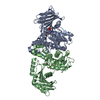




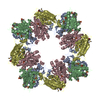

 PDBj
PDBj





